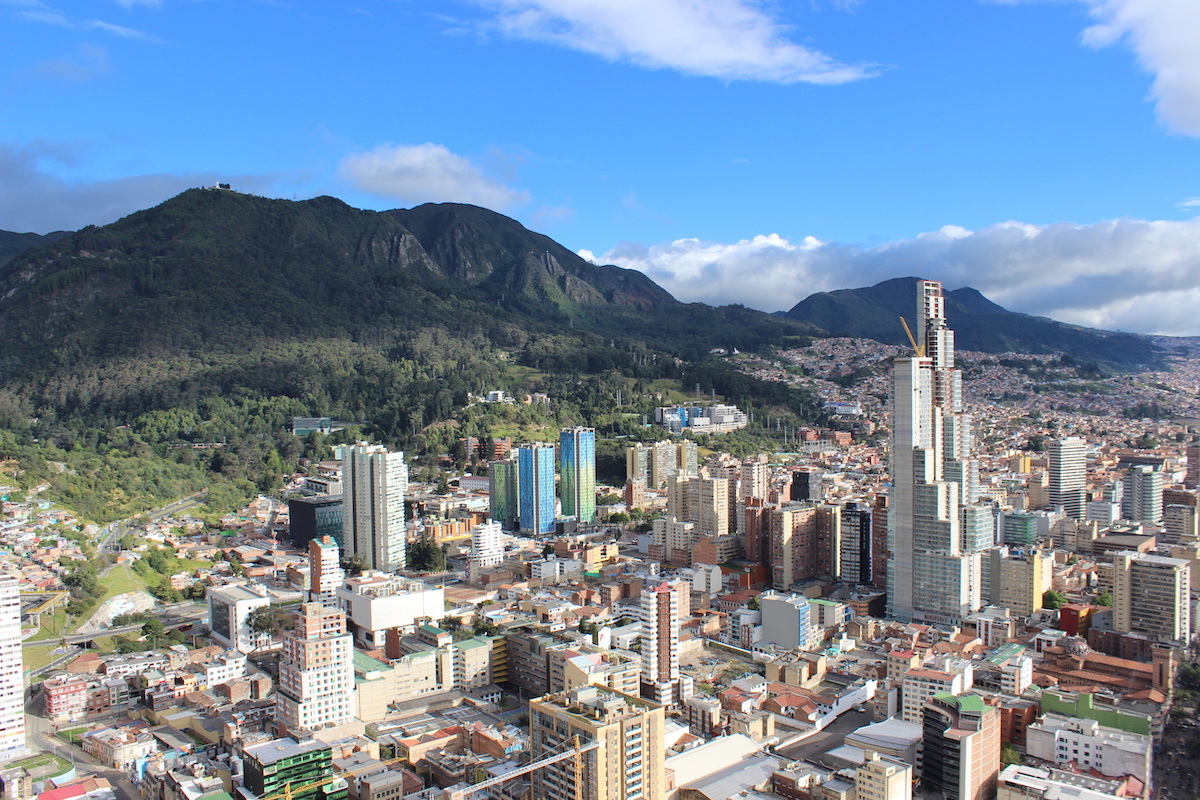Recommended
COVID-19 has spread more slowly in Colombia than in some countries. Following the onset of the pandemic, it took 100 days for daily cases (7-day moving average) to reach 100 per million, in contrast to 20 days in Italy, Spain, and the US, and close to 60 days in Brazil, Chile, and Peru. Still, case numbers and deaths continue to rise in Colombia, and the challenges ahead are significant. In a recent note, we look behind these numbers to understand Colombia’s policy responses to the COVID-19 pandemic to date. We offer six recommendations for policymakers, aimed at supporting economic and health responses to the pandemic that work hand-in-hand moving forward.
A slower spread and fewer deaths
Colombia has performed better than advanced economies and similar countries in Latin America and the Caribbean in daily COVID-19 deaths. While COVID-19 has yet to reach five daily deaths per million in Colombia, it took less than 60 days to reach this fatality rate in Brazil, Mexico, Peru, and Chile. Meanwhile, Italy and Spain reached a peak of daily deaths between 20 and 30 per million within 30 days.
However, Colombia has failed to bend the curve of the virus. Both daily cases and daily deaths are still increasing, suggesting that the virus has been tamed but not controlled. There has been some convergence in terms of the daily rates among Latin American countries, including Colombia. Daily deaths (per million inhabitants) are higher than what was observed for advanced economies after 100 days of the outbreak (figure 1).
Figure 1. Daily deaths per million inhabitants (7-day moving average)
Following methodological changes, the total number of deceased in Spain was reduced by 1,918 cases in May 25 and 1,179 in June 19. Dashed lines show the interquartile range (i.e., all countries in the dataset lie within this range, excluding the bottom and top 25 percent).
Source: Own calculations with data downloaded from Max Roser, Hannah Ritchie, Esteban Ortiz-Ospina and Joe Hasell (2020), ourworldindata.org, (downloaded on 07-19-2020).
Colombia’s positivity rates have increased despite the significant expansion in testing capacity. The number of labs capable of processing tests for the virus increased to 93 in July 2020 from just one before the pandemic, resulting in an exponential increase in daily tests, which are now higher than in most countries in the region with the exception of Chile. However, the positivity rate has been consistently above 10 percent during the last 60 days and shows an upward trend.
Initial evidence suggests that contact tracing has been increasingly less effective. At the beginning of May, close to 45 percent of cases had been identified through contact tracing. This number had fallen to 10 percent by mid-July.
Health responses
COVID-19 has fueled an expansion of Colombia’s medical infrastructure. Colombia now has 7,950 ICUs compared to 5,400 before the pandemic. ICU occupancy rates at the national level have remained below 75 percent (67 percent on July 16—updated data available here). Further ICU capacity expansion will eventually be constrained by the availability of medical personnel to support these facilities.
Colombia adopted lockdowns relatively early, perhaps too early. In economies with a large share of informal activity like Colombia, it is harder to generate income during lockdowns since informal jobs—which mostly require human contact—are difficult to perform from home. When households are unable to generate income staying at home, they are unlikely to observe lockdown requirements. According to Google mobility data, effective confinement has been falling while the virus continues to spread. This contrasts with the experience in Europe, especially Italy, Spain, and France, where people stayed in their houses until the virus had been controlled (figure 2).
Figure 2. Google mobility data and contagion rates – Colombia vs. Spain
Source: Own calculations with data downloaded from Max Roser, Hannah Ritchie, Esteban Ortiz-Ospina and Joe Hasell (2020), ourworldindata.org, and Google Community Mobility Report, both downloaded 07-19-2020
Adding to the lockdown fatigue, there has been significant uncertainty about the quarantine measures. Information about the possible paths out of lockdown has not been clearly communicated. The decisions are explained once they are taken, with lack of clear guidelines on what to expect next. With more information on the factors and reasons underlying the lockdown policy, individuals make better decisions, and if they understand why difficult policies are necessary, they can get behind them. Furthermore, policies should be implemented according to the need of each region: there is significant heterogeneity within Colombia. According to the Ministry of Health, close to 65 percent of municipalities are either COVID-free or have low incidence. The government must have the flexibility and, backed by local authorities, determine an adequate strategy for each context.
Economic policy responses
Colombia’s government and the central bank responded to COVID-19 with an innovative policy mix. The central bank acted promptly by cutting rates and providing liquidity to the market. Specifically, it implemented a bond purchase program for the first time (i.e., quantitative easing). The bank’s quick and determined action allowed financial conditions to ease, with government bond yields returning to pre-COVID levels by mid-May, after peaking in March.
Likewise, the government used existing cash transfer programs to provide additional support to low-income households. On top of that, a new program, Ingreso Solidario, was rapidly introduced to provide unconditional cash transfers to 2.9 million poor and vulnerable households that, before COVID-19, were not beneficiaries of these programs.
Moreover, in an effort to prevent the loss of formal jobs, the government adopted a program to subsidize payrolls (Programa de Apoyo al Empleo Formal) that pays 40 percent of the minimum wage to all employees in firms with at least 20 percent losses in revenues. Finally, the government stepped up credit guarantees to help alleviate businesses’ liquidity needs. Total emergency spending amounts to 2.7 percent of GDP this year.
Initial numbers measuring COVID-19’s impact indicate that economic activity has been severely hit. In May, the unemployment rate rose to 21.4 percent. Relative to the same months in 2019, the number of employed people fell by 5.5 million in April and by 4.9 million in May. The number of jobs has dropped to the level observed at the end of 2006.
To minimize the damage to economic activity, the government decided to gradually reopen the economy by allowing some nonessential sectors to go back to work, starting on April 28. The effects of this gradual reopening can be observed in leading indicators. Activity seems to be recovering but remains far from pre-COVID levels. Given that the pandemic situation is not improving, and that more severe lockdowns with fewer exceptions were reintroduced in some parts of the country, it will be harder for economic activity to continue picking up—not only because of reimposed lockdowns, but also because people will increase their precautionary behavior and reduce consumption.
Recommendations to improve health and economic outcomes
Colombia managed to slow down COVID-19’s contagion rate and contain daily deaths. However, COVID-19 is yet to reach its peak. To prevent further deterioration in health and economic outcomes, we offer six recommendations:
-
Continue to promote social distancing. Awareness campaigns, enforcement of preventive protocols, and widespread use of face masks are crucial to maintaining the capacity of already-stretched ICUs.
-
Continue strengthening the health care system. Health workers should be equiped with the necessary protective equipment and tested continuously for COVID-19. Efforts to increase ICU capacity should be expedited.
-
Implement new testing and tracing strategies quickly. The lag time between the onset of symptoms and diagnosis must be reduced and contact tracing improved. Colombia’s new testing and tracing strategy (PRASS - Pruebas, Rastreo y Aislamiento Selectivo Sostenible) should be more quickly and widely implemented.
-
Adopt differential strategies across regions. Policies should be implemented according to the need of each region.
-
Set up and announce a reopening plan contingent on the pandemic status. The people of Colombia need to be informed of the possible paths ahead of them. With more information, people can make better decisions and increase the effectiveness of difficult policies, such as lockdowns.
-
Extend economic support programs in time and in beneficiaries. COVID-19 has revealed holes in Colombia’s social safety net. Nearly 2 million poor and vulnerable households were excluded from Ingreso Solidario because they barely missed the elibility criteria, and many workers—especially informal—are not reached by Programa de Apoyo al Empleo Formal. These programs should be expanded both in the scope of their coverage and in their time horizon.
La propagación del COVID-19 ha sido más lenta en Colombia que en otros países. En España, Estados Unidos o Italia apenas pasaron 20 días desde que se desató la pandemia hasta que se alcanzaron los 100 casos diarios por millón de habitantes (calculados usando una media móvil de 7 días). Y, mientras que Brasil, Chile y Perú se tardó 60 días en alcanzar estos números, en Colombia tomó 100 días. Pese a esto, el número de casos y muertes continúa aumentando en Colombia y el país enfrenta grandes desafíos. En una nota reciente, analizamos qué hay detrás de estos números para entender las respuestas de Colombia a la pandemia. Ofrecemos a los formuladores de políticas seis recomendaciones que buscan apoyar dos respuestas que van de la mano: la económica y la sanitaria.
Menos propagación y menos muertes
Colombia ha tenido mejores resultados en términos de muertes diarias por COVID-19 que las economías avanzadas y que países similares en América Latina y el Caribe. El país todavía no ha llegado a las cinco muertes diarias por millón debido al COVID-19. Sin embargo, Brasil, Chile, México y Perú tardaron menos de 60 días en alcanzar ese ratio de fatalidad. Por su parte, España e Italia alcanzaron un pico de muertes diarias de entre 20 y 30 por millón en apenas 30 días.
No obstante, y pese a sus intentos, Colombia no ha logrado doblar la curva del virus. Tanto los casos como las muertes diarias continúan aumentando, lo que sugiere que el virus se ha controlado ligera pero no totalmente. Los ratios diarios de los países latinoamericanos han comenzado a converger y los números de muertes diarias (por millón de habitantes) son más altos que los que se observaban en economías avanzadas 100 días despues del estallido del brote.
Figura 1. Muertes diarias por millón de habitantes (media móvil de 7 días).
Tras cambios metodológicos, el número total de fallecidos en España se redujo en 1.918 para el 25 de mayo y en 1.179 el 19 de junio. Las líneas punteadas muestran el rango intercuartil, lo que significa que todos los países en la base de datos están dentro de este rango, que excluye el 25 por ciento superior e inferior.
Fuente: Cálculos de los autores con datos de Max Roser, Hannah Ritchie, Esteban Ortiz-Ospina Joe Hasell (2020), ourworldindata.org, (descargados el 19 de julio de 2020).
Pese a una gran expansión de la capacidad de testeo, los ratios de positividad de Colombia han aumentado. El número de laboratorios capaces de procesar test de coronavirus aumentó de uno antes de la pandemia a 93 en julio. Esto ha resultado en un incremento exponencial en el número de test diarios, el más alto de la región solo por detrás de Chile. Sin embargo, el ratio de positividad se ha mantenido consistentemente por encima del 10 por ciento durante los últimos 60 días y presenta un tendencia al alza.
Por otro lado, el seguimiento de contactos es cada vez menos efectivo. A principios de mayo, cerca del 45 por ciento de los casos se identificaban a través del seguimiento de contactos, pero, a mediados de julio, este número había caído al 10 por ciento.
La respuesta sanitaria
El COVID-19 ha motivado una expansión de la infraestructura médica en Colombia. El país tiene ahora 7.950 UCIs, en comparación con las 5.400 que tenía antes de la pandemia. A nivel nacional, los ratios de ocupación de las UCIs se han mantenido por debajo del 75 por ciento (67 por ciento a 16 de julio – se pueden ver los datos actualizados aquí). Sin embargo, una mayor expansión del número de UCIs se verá eventualmente limitada en función de la disponibilidad de personal médico que gestione las instalaciones.
Colombia impuso confinamientos relativamente pronto, quizás demasiado pronto. En economías con una alta proporción de actividad informal, como Colombia, es más difícil generar ingresos durante los confinamientos ya que os trabajos informales, que en su mayoría requieren contacto humano, no se pueden realizar desde casa. Es poco probable que las familias que no tienen ingresos si se quedan en casa respeten las medidas de confinamiento. Según los datos de movilidad de Google, el confinamiento ha sido cada vez menos efectivo mientras el virus continúa propagándose. Esto contrasta con la experiencia europea, especialmente en España, Francia e Italia, donde la población se quedó en sus casas hasta que el virus se había controlado (figura 2).
Figura 2. Datos de movilidad de Google y ratios de contagio – Colombia vs España
Fuente: Cálculos de los autores con datos de Max Roser, Hannah Ritchie, Esteban Ortiz-Ospina Joe Hasell (2020), ourworldindata.org, Google Community Mobility Report (descargados el 19 de julio de 2020).
Además de la fatiga relacionada con los confinamientos, ha habido una gran incertidumbre en torno a las medidas de cuarentena. La información sobre los posibles cambios programáticos sobre el final del confinamiento no ha sido comunicada de manera clara. Las decisiones solo se explican despues de haber sido tomadas, sin unas directrices claras acerca de qué esperar más adelante. Los individuos toman mejores decisiones cuando tienen información sobre los factores y razones que motivan las políticas de confinamiento y pueden apoyar medidas difíciles si comprenden por qué son necesarias. Por otro lado, las políticas deben implementarse de acuerdo con las necesidades de cada región: hay una gran heterogeneidad dentro de Colombia. Según el Ministerio de Salud, cerca del 65 por ciento de las municipalidades están libres de COVID o sufren una baja incidencia. El gobierno debe ser flexible y, apoyado por las autoridades locales, establecer una estrategia adecuada para cada contexto.
La respuesta económica
El gobierno de Colombia y el banco central han respondido al COVID-19 con una mezclad de políticas innovadora. El banco central actuó rápidamente reduciendo los tipos de interés y aportando liquidez al mercado. En concreto, implemento por primera vez un programa de compra de bonos (también llamado quantitative easing o expansión cuantitativa). Esta rápida y contundente acción facilito que las condiciones financieras mejoraran y el yield de los bonos del gobierno volvió a mediados de mayo a los niveles pre-COVID, tras los máximos de marzo.
Asimismo, el gobierno utilizo programas existentes de transferencias directas para dar apoyo adicional a las familias de bajo ingreso. Además, introdujeron rápidamente un nuevo programa, Ingreso Solidario, para hacer llegar transferencias directas y sin condiciones a 2,9 millones de familias pobres y vulnerables que antes del COVID-19 no eran beneficiarias de estos programas.
También, en un esfuerzo para prevenir la pérdida de los empleos formales, el gobierno adoptó un programa para subsidiar los salarios (Programa de Apoyo al Empleo Formal) que paga el 40 or ciento del salario mínimo a todos los empleados de empresas que hayan perdido al menos un 20 por ciento de sus ingresos. Por último, el gobierno aumentó las garantías de crédito para aliviar las necesidades de liquidez de las empresas. El gasto total de emergencia de este año es de un 2,7 por ciento de PIB.
Los números preliminares que miden el impacto del COVID-19 indican que la actividad económica ha sufrido un severo golpe. En mayo, el desempleo subió al 21,4 por ciento. En comparación con los mismos meses de 2019, el número de población empleada cayó en 5,5 millones en abril y 4,9 millones en mayo. El número de empleados ha caído a los niveles de finales de 2006.
Para minimizar el daño a la actividad económica, el gobierno decidió reabrir gradualmente la economía permitiendo que algunos sectores no-esenciales volvieran a trabajar a partir del 28 de abril. Los efectos de esta reapertura gradual se pueden observar en indicadores adelantados. La actividad parece estar recuperándose, pero se mantiene lejos de los niveles pre-COVID. Dado que la situación de la pandemia no está mejorando, y que se han reintroducido en algunas partes del país confinamientos aún más severos y con menores excepciones, será difícil que la actividad económica continúe recuperándose (no solo por los nuevos confinamientos, sino también porque la población se comportará de una forma más precavida y reducirá su consumo).
Recomendaciones para mejorar los resultados sanitarios y económicos
Aunque Colombia logró ralentizar el ratio de contagio y contener el número de muertes diarias, el COVID-19 todavía no ha alcanzado su pico. Para prevenir un mayor deterioro de las condiciones sanitarias y económicas, ofrecemos seis recomendaciones:
- Continuar promoviendo el distanciamiento social. Las campañas de concienciación, la aplicación de protocolos preventivos y el uso extendido de mascarillas son cruciales para mantener la capacidad de las UCIs, que ya se encuentran bajo presión.
- Continuar fortaleciendo el sistema de salud. Los trabajadores sanitarios deben tener el equipamiento de protección necesario y acceso a pruebas de COVID-19 de manera regular. Se deben acelerar los esfuerzos para aumentar la capacidad de las UCIs.
- Implementar rápidamente nuevas pruebas y estrategias de seguimiento. Se debe reducir el tiempo que pasa entre la aparición de los síntomas y el diagnóstico y mejorar el seguimiento de contactos.
- Adoptar diferentes estrategias regionales. Las políticas deben implementarse de acuerdo con las necesidades de cada región.
- Establecer y anunciar un plan de reapertura contingente en el estado de la pandemia. La población necesita estar informada sobre los posibles futuros escenarios que se contemplan. Con más información, la gente puede tomar mejores decisiones y ampliar la efectividad de políticas complicadas como los confinamientos.
- Extender los programas de apoyo económico durante más tiempo y ampliar su alcance a más beneficiarios. El COVID-19 ha revelado las carencias de las redes de seguridad social de Colombia. Casi 2 millones de familias pobres y vulnerables quedaron excluidas del Ingreso Solidario porque, por poco, no cumplían el criterio de elegibilidad y el Programa de Apoyo al Empleo Formal no ha llegado muchos trabajadores (sobre todo informales). Estos programas deben expandir tanto su cobertura como su horizonte temporal.
Disclaimer
CGD blog posts reflect the views of the authors, drawing on prior research and experience in their areas of expertise. CGD is a nonpartisan, independent organization and does not take institutional positions.
Image credit for social media/web: Photo by Dominic Chavez / World Bank










